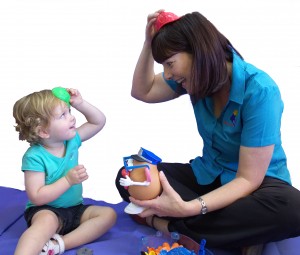
Many therapists use play based therapy to develop children’s skills. Sometimes to a parent this may look like the child and therapists are “just playing”. Play is however a powerful tool in developing children’s skills in communicating, learning and relating to others.
It is something that can be used effectively by both therapists and parents and has the added advantages of being fun and helping parent and child to bond. Stanley Greenspan in his book “The Learning Tree” wrote “Playtime is an opportunity for children and parents to connect, share and bond.” He writes about play’s ability to develop thinking and learning skills “All children gain from this extra boost, but children with learning difficulties- gain-and need it the most”.
Greenspan calls his method of play “floortime”. He describes three essential things:
1. Follow your child’s lead.
2. Challenge your child to be creative and spontaneous.
3. Expand the action and interaction to include all your child’s senses, motor skills as well as some emotions.
Following your child’s lead can be difficult in the beginning. As adults we often feel our role is to lead and direct our children. If we are able to let our child lead our children are more involved, motivated, engaged and attentive to the activity and so stay more focused and learn more.
Try putting out a range of play things and sit back and watch what they choose. Then watch what they do with it. They may not use it the way that is expected. They may get a toy saucepan and put it on their head as a hat, they may want to play with the box rather than the toy inside. Sit and observe for a few minutes what your child does when they are in the lead. Once you can see what your child wants to do with their play, join in gently. Greenspan describes the adults role as “merely a fun-and non intrusive-supporting actor”. Move alongside your child and do what they are doing. Talk about what you see them do.
Challenge your child to be spontaneous and creative. Greenspan states that gentle challenges as a part of interaction help children move to higher levels of thinking. You might ask a question about what your child could do. You might pretend that you cannot get your toy to work. If your child has problems with something don’t fix it for them immediately. Challenge them to work it out for themselves. Offer them choices. Ask them why they made the choice they did. If the saucepan is too small for your head, what could you use as a hat? Why did a bowl work, why did the plate not work?”
Expand the interaction. Build on your child’s play. Bring a doll or teddy into the game and ask your child if they could dress up too. What things can you do wearing your saucepan hat, can you go out in the rain, can you ride a motorbike, can you be a soldier, act these ideas out with your child. Let your hat fall off, how do you feel? Are you sad or frustrated that your hat won’t stay on. Help your child explore feelings through their play.
Here are some more ideas to make play a fun learning time for your child:
1. Choose quality toys. Choose toys that are strong and safe and therefore give value for money. Choose ones that can be used in a range of different ways and therefore can grow with your child as they develop. Sometimes simple toys are the most flexible, while expensive electronic toys can only be used for one purpose.
2. Choose toys appropriate for your child’s level. While you want your child to be challenged, a toy that is too hard for your child to use is frustrating. Choose toys that suit your child’s developmental level and motor skills. Bigger items are usually easier for little hands to use.
3. Choose toys that can be used for pretend play. Pretend play is great for developing language, thinking and social skills. Try dolls or animals, cooking toys and tea sets, farm sets and cars, trucks and building items.
4. Play with your child. Try to set aside some time each day to play together. It’s great for developing relationships, learning, language and social skills. A child can learn how to share and take turns with an adult and can then play better with other children.
5. Offer a range of toys. Follow your child’s interests but don’t be too restricted by them. Try expanding into related areas. If your child likes cars, what about trucks, trains and other transport. Try a toy library or swap with friends to offer a range of toys and check out second hand shops for pre loved bargains.
6. Play is not just about toys. Play can include real items such as dress ups and things from the kitchen as well as outdoor activities, sand, water and even mud. It can also include craft activities and just using imagination.
Remember most of all to have fun!
Most Talking Matters speech pathologists have completed basic Floortime training. You can find out more about Floortime and the work of Stanley Greenspan here. browse our website for more information about children's development and helping children with special needs.
Related posts:
Developing play
Fun with pretending
The importance of play
Related Blog Posts
If you liked this post you may also like:
Using GO FISH To Grow
What is ADD and ADHD?
Activities for christmas
Developing the Pencil Grasp



